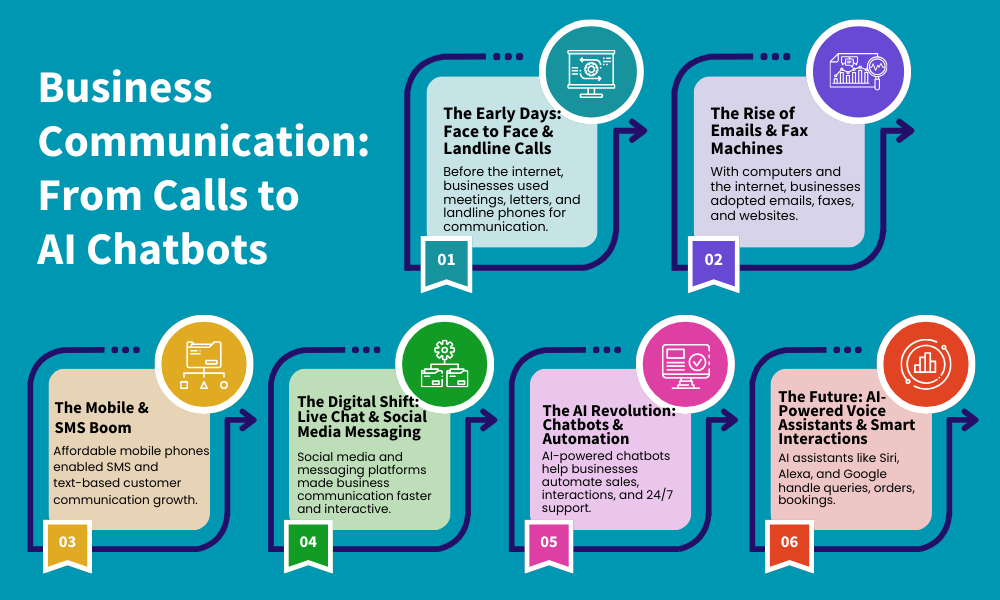
Business communication has evolved drastically over the decades. What started with face-to-face meetings and telephone calls has now transformed into instant messaging, video conferencing, and AI-driven chatbots.
In today’s fast-paced digital era, businesses must adapt and innovate to keep up with customer expectations, automation, and efficiency. In this blog, we’ll explore how business communication evolved from traditional calls to AI-powered chatbots and what the future holds.
1. The Early Days: Face-to-Face & Landline Calls (Pre-1990s)
Before the internet revolution, businesses relied on face-to-face meetings, letters, and landline telephones for communication.
📞 Landline calls became the primary mode of customer service, enabling real-time conversations.
💼 Business impact:
✅ Direct, personal communication
✅ Customers received real-time solutions
🚫 Challenges:
❌ Time-consuming & costly
❌ Limited to business hours
❌ Not scalable for large businesses
🔹 Example: A customer calling their local bank branch to check account details or report lost cards.
2. The Rise of Emails & Fax Machines (1990s - Early 2000s)
With the rise of computers and the internet, businesses embraced emails, fax machines, and corporate websites.
📧 Emails revolutionized communication by allowing businesses to send detailed messages, contracts, and invoices instantly.
💼 Business impact:
✅ Faster communication than phone calls
✅ Allowed for record-keeping & documentation
🚫 Challenges:
❌ Emails often went unread or landed in spam
❌ Slow response times
❌ No real-time interaction
🔹Example: Companies started sending newsletters, order confirmations, and support tickets via email instead of phone calls.
3. The Mobile & SMS Boom (2000s - 2010s)
As mobile phones became more affordable and widely available, SMS and text-based customer communication took off.
📲 Businesses used SMS for:
✔ Appointment reminders
✔ Order updates & tracking
✔ Promotional offers & discounts
💼 Business impact:
✅ Instant delivery of important information
✅ Increased reach with mobile accessibility
🚫 Challenges:
❌ One-way communication (no customer interaction)
❌ Limited to 160 characters**
❌ Overuse led to spam messages
🔹 Example: Retail stores & telecom companies started sending discount offers and bill payment reminders via SMS.
4. The Digital Shift: Live Chat & Social Media Messaging (2010s - Present)
The rise of social media and instant messaging platforms transformed business communication. Customers wanted faster, real-time, and more interactive responses.
🌐 Businesses started using:
✔ Live chat on websites (for quick support)
✔ WhatsApp, Facebook Messenger, & Instagram DMs
✔ Chatbots for instant responses
💼 Business impact:
✅ Customers could reach brands instantly
✅ Multi-channel communication (website, social media, apps)
✅ Brands engaged customers on platforms they already used
🚫 Challenges:
❌ Required dedicated staff to respond
❌ Handling high volumes of queries became difficult
🔹 Example: E-commerce brands started using WhatsApp Business & Facebook Messenger to help customers track orders, process refunds, and answer FAQs.
5. The AI Revolution: Chatbots & Automation (Present - Future)
With the explosion of AI and automation, businesses are now moving towards AI-powered chatbots to handle customer interactions, automate sales, and provide 24/7 support.
🤖 How AI chatbots are transforming business communication:
✔ Instant Responses – No more waiting for a support agent
✔ 24/7 Availability – Businesses can engage with customers anytime
✔ Multilingual Support – Chatbots can respond in multiple language
✔ Cost Savings – Reduces the need for large customer support teams
✔ Integration with CRM & Payments – Businesses can track interactions and even process orders/payments within chat
💼 Business impact:
✅ Scalable & cost-effective
✅ Handles thousands of queries simultaneously
✅ Provides personalized & data-driven responses
🚫 Challenges:
❌ Requires proper setup & training to function effectively
❌ Complex queries may still require human intervention
🔹 Example: Airlines & banks now use AI chatbots to help customers check flight status, book tickets, get banking details, and process refunds—without speaking to an agent.
6. The Future: AI-Powered Voice Assistants & Smart Interactions
The next stage of business communication will include:
💡 Conversational AI & Smart Assistants – AI systems like Siri, Alexa, and Google Assistant will handle business queries, orders, and bookings via voice.
💡 Hyper-Personalized Interactions – AI will analyze customer preferences & behaviors to offer customized recommendations instantly.
💡 Seamless Omnichannel Communication – Businesses will unify WhatsApp, social media, chatbots, and voice assistants into a single communication system.
🔹 Example: Imagine a restaurant where customers can book a table via WhatsApp chatbot, receive confirmation via email, and ask an AI voice assistant for dietary recommendations—all without human intervention!

